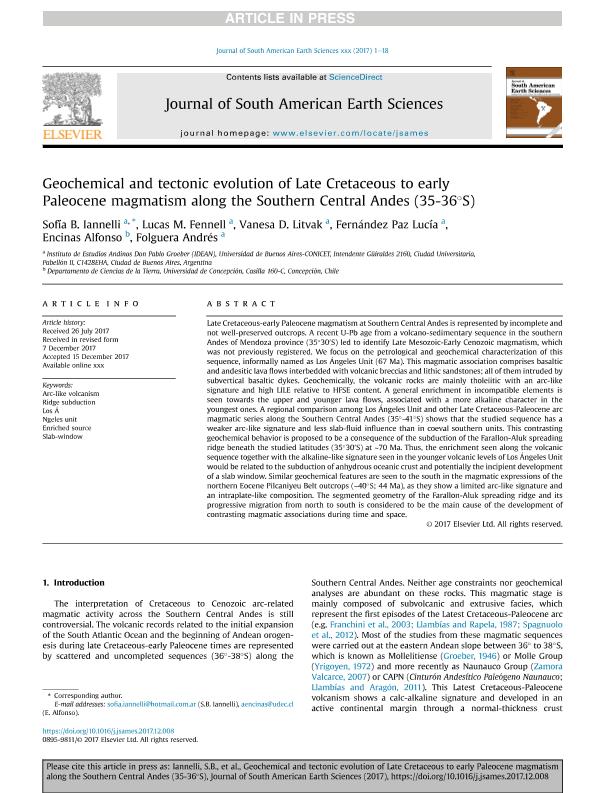Artículo
Geochemical and tectonic evolution of Late Cretaceous to early Paleocene magmatism along the Southern Central Andes (35-36°S)
Iannelli, Sofía ; Fennell, Lucas Martín
; Fennell, Lucas Martín ; Litvak, Vanesa Dafne
; Litvak, Vanesa Dafne ; Fernández Paz, Lucía
; Fernández Paz, Lucía ; Encinas, Alfonso; Folguera Telichevsky, Andres
; Encinas, Alfonso; Folguera Telichevsky, Andres
 ; Fennell, Lucas Martín
; Fennell, Lucas Martín ; Litvak, Vanesa Dafne
; Litvak, Vanesa Dafne ; Fernández Paz, Lucía
; Fernández Paz, Lucía ; Encinas, Alfonso; Folguera Telichevsky, Andres
; Encinas, Alfonso; Folguera Telichevsky, Andres
Fecha de publicación:
11/2018
Editorial:
Pergamon-Elsevier Science Ltd
Revista:
Journal of South American Earth Sciences
ISSN:
0895-9811
Idioma:
Inglés
Tipo de recurso:
Artículo publicado
Clasificación temática:
Resumen
Late Cretaceous-early Paleocene magmatism at Southern Central Andes is represented by incomplete and not well-preserved outcrops. A recent U-Pb age from a volcano-sedimentary sequence in the southern Andes of Mendoza province (35°30′S) led to identify Late Mesozoic-Early Cenozoic magmatism, which was not previously registered. We focus on the petrological and geochemical characterization of this sequence, informally named as Los Ángeles Unit (67 Ma). This magmatic association comprises basaltic and andesitic lava flows interbedded with volcanic breccias and lithic sandstones; all of them intruded by subvertical basaltic dykes. Geochemically, the volcanic rocks are mainly tholeiitic with an arc-like signature and high LILE relative to HFSE content. A general enrichment in incompatible elements is seen towards the upper and younger lava flows, associated with a more alkaline character in the youngest ones. A regional comparison among Los Ángeles Unit and other Late Cretaceous-Paleocene arc magmatic series along the Southern Central Andes (35°-41°S) shows that the studied sequence has a weaker arc-like signature and less slab-fluid influence than in coeval southern units. This contrasting geochemical behavior is proposed to be a consequence of the subduction of the Farallon-Aluk spreading ridge beneath the studied latitudes (35°30′S) at ∼70 Ma. Thus, the enrichment seen along the volcanic sequence together with the alkaline-like signature seen in the younger volcanic levels of Los Ángeles Unit would be related to the subduction of anhydrous oceanic crust and potentially the incipient development of a slab window. Similar geochemical features are seen to the south in the magmatic expressions of the northern Eocene Pilcaniyeu Belt outcrops (∼40°S; 44 Ma), as they show a limited arc-like signature and an intraplate-like composition. The segmented geometry of the Farallon-Aluk spreading ridge and its progressive migration from north to south is considered to be the main cause of the development of contrasting magmatic associations during time and space.
Archivos asociados
Licencia
Identificadores
Colecciones
Articulos(IDEAN)
Articulos de INSTITUTO DE ESTUDIOS ANDINOS "DON PABLO GROEBER"
Articulos de INSTITUTO DE ESTUDIOS ANDINOS "DON PABLO GROEBER"
Citación
Iannelli, Sofía; Fennell, Lucas Martín; Litvak, Vanesa Dafne; Fernández Paz, Lucía; Encinas, Alfonso; et al.; Geochemical and tectonic evolution of Late Cretaceous to early Paleocene magmatism along the Southern Central Andes (35-36°S); Pergamon-Elsevier Science Ltd; Journal of South American Earth Sciences; 87; 11-2018; 139-156
Compartir
Altmétricas



